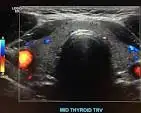갑상선 초음파 해석 방법: 3가지 필수 방법
갑상선 초음파는 목의 기저부에 위치한 작은 나비 모양의 갑상선 건강을 평가하기 위한 중요한 이미지 기술입니다. 이 가이드는 갑상선 초음파가 무엇을 보여줄 수 있는지, 왜 사용되는지, 결과를 해석하는 방법을 이해하는 데 도움을 줄 것입니다.
갑상선 초음파란 무엇인가요?
갑상선 초음파는 음파를 사용하여 갑상선의 실시간 이미지를 생성하는 안전하고 비침습적인 방법입니다. 이 기술의 주요 발견과 그 중요성을 살펴보겠습니다.

갑상선 초음파는 무엇을 보여줄 수 있나요?
- 결절 탐지: 갑상선 결절, 크기, 모양 및 특성을 식별합니다.
- 낭종 평가: 갑상선 낭종을 감지하고 평가하여 액체로 채워져 있는지 고형인지 판단합니다.
- 선의 크기와 형상: 갑상선의 전반적인 크기와 형상을 평가하고 갑상선 비대(갑상선종)를 확인합니다.
- 혈류: 갑상선 내 및 결절의 혈류를 시각화할 수 있습니다.
- 바이옵시 안내: 의심되는 결절의 세침흡입 바이옵시를 안내하는 데 사용됩니다.
갑상선 초음파가 필요할 수 있는 이유는 무엇인가요?
- 촉지 가능한 결절: 목의 신체 검사 중 결절이 촉지될 때.
- 비정상적인 혈액 검사: 갑상선 호르몬 수치(TSH, T3, T4)가 비정상일 때.
- 갑상선종 의심: 확대된 갑상선을 검사하기 위해.
- 추적 이미지: 알려진 갑상선 결절 또는 조건의 진행 상황을 모니터링하기 위해.
- 목 통증 또는 부기: 목의 불편함의 원인을 판단하기 위해.
갑상선 초음파는 어떻게 수행되나요?
갑상선 초음파는 간단하고 무통증인 절차로, 일반적으로 의사 사무실이나 이미징 센터에서 수행됩니다. 과정 중 기대할 수 있는 사항은 다음과 같습니다.
준비
- 특별한 준비 없음: 일반적으로 특별한 준비는 필요하지 않습니다. 스캔 전 정상적으로 먹고 마실 수 있습니다.
- 옷차림: 목에 쉽게 접근할 수 있는 편안한 옷을 입으세요. 목걸이나 장신구는 제거하라고 요청받을 수 있습니다.
절차 단계
- 위치 선정: 등을 대고 누워서 목을 약간 늘입니다. 어깨 아래에 베개나 쿠션이 놓일 수 있습니다.
- 젤 도포: 목 위 피부에 투명한 수용성 젤을 도포합니다. 이 젤은 변환기(탐침)가 피부와 더 잘 접촉하도록 도와줍니다.
- 변환기 이동: 초음파 기술자가 목 위에서 변환기를 부드럽게 이동시키며 갑상선의 실시간 이미지를 캡처합니다.
- 이미지 취득: 초음파 기계가 모니터에 이미지를 표시하고 기술자가 여러 가지 측정을 할 수 있습니다.
- 소요 시간: 절차는 일반적으로 약 15분에서 30분 정도 소요됩니다.
- 청소: 절차가 끝난 후 젤이 닦여지고, 정상 활동으로 돌아갈 수 있습니다.

기대할 사항
- 무통증: 절차는 무통증이며 비침습적입니다.
- 편안함: 변환기가 목을 이동할 때 약간의 압력을 느낄 수 있습니다.
- 실시간: 초음파 기술자는 갑상선을 실시간으로 볼 수 있어 정밀한 평가가 가능합니다.
갑상선 초음파 결과 해석 방법
갑상선 초음파 결과를 이해하는 것은 적절한 건강 관리 관리를 위해 중요합니다. 다음은 결과 해석에 도움을 줄 수 있는 방법에 대한 개요입니다.
1. X-ray Interpreter 활용하기
X-ray Interpreter는 갑상선 스캔을 포함한 초음파 이미지의 AI 기반 분석을 제공합니다:
- 등록: X-ray Interpreter에 가입하여 AI 분석 도구에 접근하세요.
- 초음파 업로드: 분석을 위해 갑상선 초음파 이미지를 업로드하세요.
- 해석 검토: AI가 생성한 해석 및 종합 보고서를 받습니다.
- 상담: 완전한 진단을 위해 항상 의료 제공자의 조언을 구하십시오.
더 자세한 내용은 시작 가이드를 확인하세요.
2. ChatGPT Plus 사용하기
ChatGPT Plus는 GPT-4V 모델을 사용하여 초음파 이미지 분석을 지원할 수 있습니다:
- 구독: 고급 분석 기능을 위해 ChatGPT Plus를 구독하세요.
- 초음파 업로드: OpenAI 플랫폼에 갑상선 초음파 이미지를 업로드하세요.
- 분석 요청: AI에 이미지 해석을 요청하고 보고서를 제공받습니다.
- 결과 검토 및 검증: 정확성을 위해 의료 전문가와 결과를 검토하세요.
의료 이미지 해석을 위한 ChatGPT Plus 사용법에 대한 더 많은 내용은 블로그에서 확인하세요.
또는 여러 비전 기능을 갖춘 다른 AI 모델이 등장함에 따라, xAI의 Grok, Anthropic의 Claude 및 Google Deepmind의 Gemini와 같은 다른 모델을 시도해 볼 수도 있습니다.
3. 스스로 기본 이해하기
의료 전문가와 상담하는 것이 중요하지만, 기본적인 이해를 통해 상담 중 자신감을 가질 수 있습니다.
- 기본 갑상선 해부학 배우기: 갑상선의 구조와 위치를 이해합니다.
- 정보 가이드 읽기: 온라인 리소스를 이용하여 초음파에서 흔한 발견을 이해합니다.
- 질문 준비: 낯선 용어나 발견 사항을 메모하고 의사에게 명확히 물어보세요.
- 전문가 상담: 항상 의료 전문가와 이해를 검증하세요.
다양한 접근 방식 비교
여기 갑상선 초음파 해석을 위한 다양한 방법의 비교가 있습니다:
| 기준 | X-ray Interpreter | ChatGPT Plus | 스스로 읽기 |
|---|---|---|---|
| 정확도 | 높음 (AI 기반)1 | 높음 (AI 기반)1 | 다양함 (기술 수준에 따라 상이) |
| 사용 용이성 | 쉬움 | 보통 | 도전적 |
| 비용 | 이미지당 $2.50부터 | 월 $20 | 무료 (교육 비용 제외) |
| 시간 효율성 | 빠름 | 보통에서 빠름 | 느리거나 보통 |
| 학습 곡선 | 낮음 | 낮음에서 보통 | 높음 |
| 추가 리소스 | 제공됨 | 부분적으로 제공됨 (OpenAI를 통해) | 스스로 조달 |
각 방법은 고유한 장점을 제공하며, AI 옵션은 빠르고 상세한 분석을 제공하고, 기본 이해는 의사-환자 간의 의사소통을 개선하는 데 도움이 됩니다.
결론
갑상선 초음파는 갑상선 건강을 평가하는 데 중요한 진단 도구입니다. 이 가이드는 절차의 유용성과 결과를 이해하기 위한 다양한 방법, 자가 연구, AI 도구 및 전문가 검증을 소개했습니다.
방법을 결정할 때 특정 요구 사항, 이해 수준 및 자원 접근을 고려하세요. 항상 개인 정보 보호 기준을 우선시하고 전문가의 의료 검증을 요청하세요.